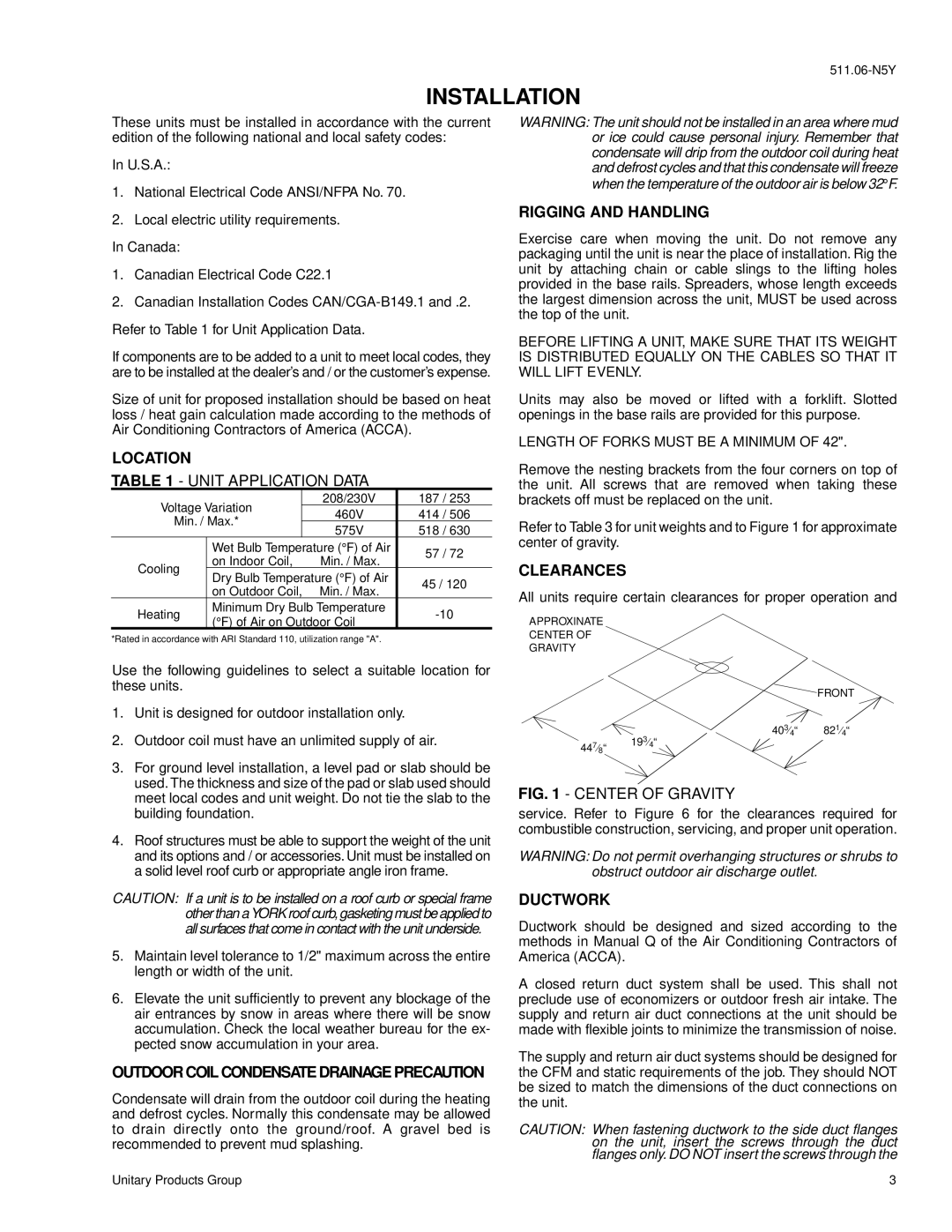
INSTALLATION
These units must be installed in accordance with the current edition of the following national and local safety codes:
In U.S.A.:
1.National Electrical Code ANSI/NFPA No. 70.
2.Local electric utility requirements.
In Canada:
1.Canadian Electrical Code C22.1
2.Canadian Installation Codes
If components are to be added to a unit to meet local codes, they are to be installed at the dealer’s and / or the customer’s expense.
Size of unit for proposed installation should be based on heat loss / heat gain calculation made according to the methods of Air Conditioning Contractors of America (ACCA).
WARNING: The unit should not be installed in an area where mud or ice could cause personal injury. Remember that condensate will drip from the outdoor coil during heat and defrost cycles and that this condensate will freeze when the temperature of the outdoor air is below 32° F.
RIGGING AND HANDLING
Exercise care when moving the unit. Do not remove any packaging until the unit is near the place of installation. Rig the unit by attaching chain or cable slings to the lifting holes provided in the base rails. Spreaders, whose length exceeds the largest dimension across the unit, MUST be used across the top of the unit.
BEFORE LIFTING A UNIT, MAKE SURE THAT ITS WEIGHT IS DISTRIBUTED EQUALLY ON THE CABLES SO THAT IT WILL LIFT EVENLY.
Units may also be moved or lifted with a forklift. Slotted openings in the base rails are provided for this purpose.
LENGTH OF FORKS MUST BE A MINIMUM OF 42".
LOCATION
TABLE 1 - UNIT APPLICATION DATA
Voltage Variation |
| 208/230V | 187 | / 253 | ||
| 460V | 414 | / 506 | |||
Min. / Max.* |
| |||||
| 575V | 518 | / 630 | |||
|
|
| ||||
| Wet Bulb Temperature (° F) of Air | 57 | / 72 | |||
| on Indoor Coil, | Min. / Max. | ||||
Cooling |
|
| ||||
Dry Bulb Temperature (° F) of Air | 45 / 120 | |||||
| ||||||
| on Outdoor Coil, | Min. / Max. | ||||
|
|
| ||||
Heating | Minimum Dry Bulb Temperature | |||||
Remove the nesting brackets from the four corners on top of the unit. All screws that are removed when taking these brackets off must be replaced on the unit.
Refer to Table 3 for unit weights and to Figure 1 for approximate center of gravity.
CLEARANCES
All units require certain clearances for proper operation and
(° F) of Air on Outdoor Coil |
*Rated in accordance with ARI Standard 110, utilization range "A".
Use the following guidelines to select a suitable location for these units.
1. | Unit is designed for outdoor installation only. |
2. | Outdoor coil must have an unlimited supply of air. |
3. | For ground level installation, a level pad or slab should be |
| used. The thickness and size of the pad or slab used should |
APPROXINATE
CENTER OF
GRAVITY
447⁄8“ 193⁄4“
![]() FRONT
FRONT
403⁄4“ 821⁄4“
meet local codes and unit weight. Do not tie the slab to the |
building foundation. |
4. Roof structures must be able to support the weight of the unit |
and its options and / or accessories. Unit must be installed on |
a solid level roof curb or appropriate angle iron frame. |
CAUTION: If a unit is to be installed on a roof curb or special frame other than a YORK roof curb, gasketing must be applied to all surfaces that come in contact with the unit underside.
5.Maintain level tolerance to 1/2" maximum across the entire length or width of the unit.
6.Elevate the unit sufficiently to prevent any blockage of the air entrances by snow in areas where there will be snow accumulation. Check the local weather bureau for the ex- pected snow accumulation in your area.
OUTDOOR COIL CONDENSATE DRAINAGE PRECAUTION
Condensate will drain from the outdoor coil during the heating and defrost cycles. Normally this condensate may be allowed to drain directly onto the ground/roof. A gravel bed is recommended to prevent mud splashing.
FIG. 1 - CENTER OF GRAVITY
service. Refer to Figure 6 for the clearances required for combustible construction, servicing, and proper unit operation.
WARNING: Do not permit overhanging structures or shrubs to obstruct outdoor air discharge outlet.
DUCTWORK
Ductwork should be designed and sized according to the methods in Manual Q of the Air Conditioning Contractors of America (ACCA).
A closed return duct system shall be used. This shall not preclude use of economizers or outdoor fresh air intake. The supply and return air duct connections at the unit should be made with flexible joints to minimize the transmission of noise.
The supply and return air duct systems should be designed for the CFM and static requirements of the job. They should NOT be sized to match the dimensions of the duct connections on the unit.
CAUTION: When fastening ductwork to the side duct flanges on the unit, insert the screws through the duct flanges only. DO NOT insert the screws through the
Unitary Products Group | 3 |
